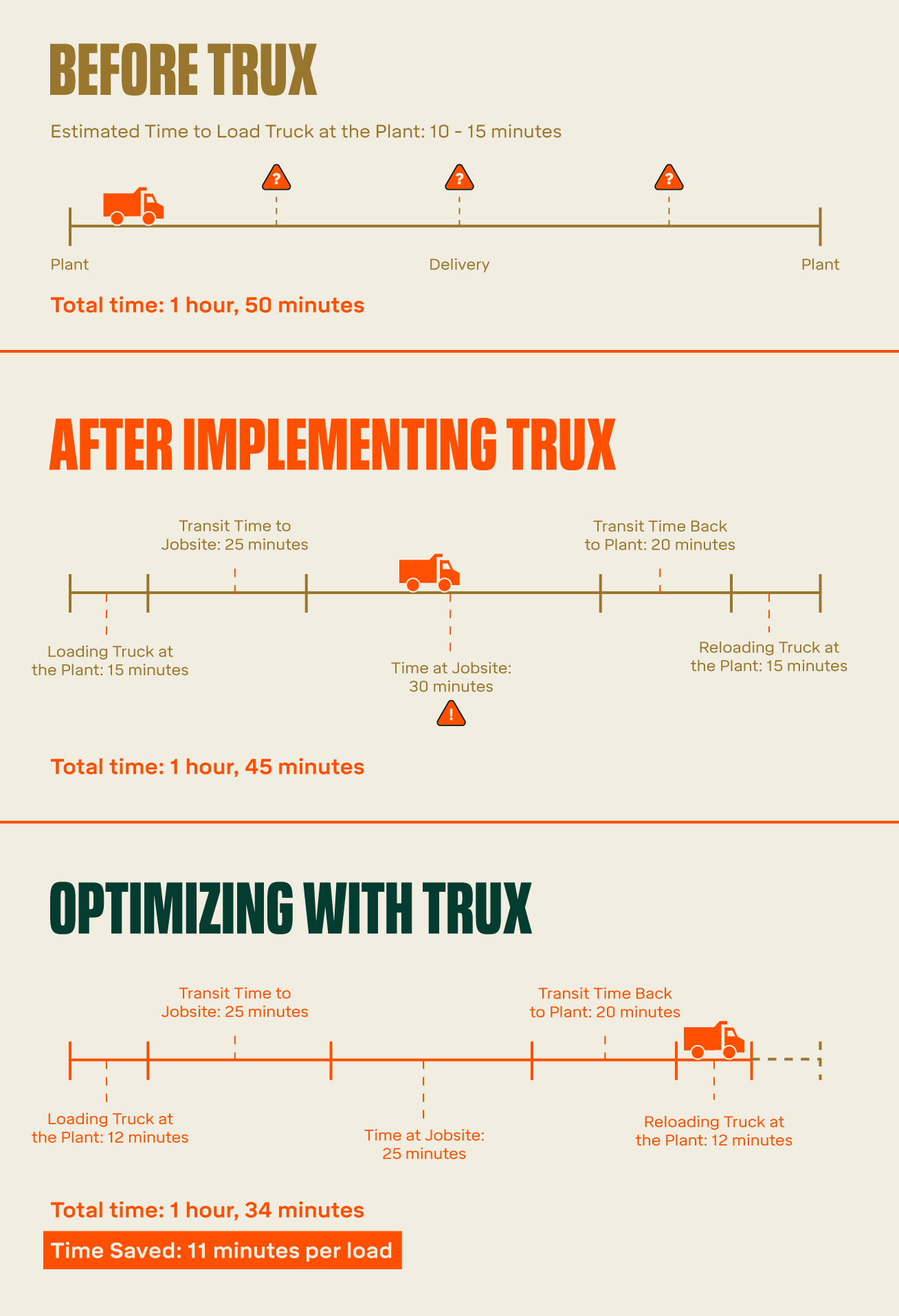8 min read
Using Construction Data to Optimize Hauling Operations
By: Elizabeth Sholes on Sep 27, 2021 9:00:00 AM

A lot of different hauled materials--from aggregates and asphalt to sand and soil--are needed to successfully complete a construction job. But what if the job at hand is to get the most out of your hauling operations? What material helps most in that case? It’s construction data. And using digital technology is by far the easiest way to collect and analyze the kinds of construction data you need to optimize your hauling.
Good news. Finding the digital tools you need for construction data is not as difficult as it once was. A quick Google search will come up with dozens of software products offering all sorts of construction data services. Who knows whether the flood of products is the cause, or result, of a shift in the construction industry. Either way, the move from functioning as a reactive culture to a proactive one is a huge step in the right direction.
An organization with a proactive culture embraces the idea of digital disruption and relies on its own data to make decisions--because the most impactful changes come from actual values rather than estimated values. However, without the right kind of technology in place, it’s extremely difficult to gather accurate data.
How often are you experiencing any or all of these scenarios?
-
Dump trucks frequently making deadhead trips
-
Lines of trucks idling for hours at an aggregate facility
-
Work crews just waiting around for a delivery
-
Trucks bottlenecked at a jobsite gate
-
Available dump trucks parked in the yard
-
Under or over trucking on a job
-
Conflicting accounts of the time it took to unload
All of the above situations are resource wasters that negatively affect your hauling operations, ultimately lowering your productivity and increasing your costs. Implementing a trucking logistics platform that includes GPS tracking can significantly reduce the number of times these inefficiencies occur. By providing you with real-time visibility and specific construction data, a digital solution does the hard work for you when it comes to optimizing the hauling component of your operations.
Geofencing and Cycle Time Reporting
A good place to start looking for your company’s construction data is with your dump truck cycle times. Right now, when you’re building a quote for a project and forecasting the trucking costs, you most likely agree on standard turnaround times at the job site, plant or quarry. Then as time goes by and the project inevitably gets behind schedule, it’s difficult to determine where the issues lie. You have only the information from the drivers and other contacts in the field to piece together a picture of what’s happening to cause delays.
It could be the trucks are taking inefficient routes. It’s a possibility that loading at the plant is taking longer than it should. Or maybe delays are due to bottlenecks at the jobsite. The problem is you just can’t know for sure. So how can you know what actions to take in order to get things back on schedule?
A digital solution allows you to use geofencing to gain actionable insights. Geofences are virtual boundaries you set up around a specific location--a quarry, plant, jobsite or dumpsite. Combined with GPS tracking, geofencing will give you a transparent and accurate view into each leg of a cycle time. Trux cycle time analysis captures six data points for each load, so you can see exactly where the delays are occurring.
For example, from the cycle-time analysis you see that transit time from the plant to the jobsite is much longer than it should have been. The data from the real-time GPS tracking (collected from the driver’s phone) shows that the route included a slow down due to road work. Armed with this detailed information, your dispatcher can choose an alternate route to save time in the future.
What if the cycle time report shows holdups are happening because trucks are lined up at the quarry waiting to pick up their loads? A solution to this problem is simply having your dispatcher stagger arrival times to prevent the bottleneck. The arrival times can be entered when the job is created.
For more helpful tips on how to use geofencing, take a look at this article. It's a quick 3-minute read.
Real-time GPS Tracking and Historical Data
Being able to make adjustments while a job is ongoing optimizes your hauling and improves customer service. When customers call in change orders, rather than letting those requests cause a hectic disruption to the schedule, or worse, not being able to accommodate them, dispatchers can manage the changes with confidence. They can scale trucking up or down as needed. Hitting daily targets is achievable with real-time tracking information. And most importantly, your customers will be impressed with your level of professionalism.
Through the use of a trucking logistics platform, real-time tracking information is saved and becomes historical data. Being able to quickly access construction data concerning routes and deliveries is invaluable when it comes to settling disputes. It’s also helpful when a driver’s account of the time spent at the pick up site doesn’t quite match up with the plant employee’s.
In addition to giving you proof for conflict resolution, having all routes verified and time-stamped gives you accurate data for planning, auditing, compliance, forecasting and estimating.

With Trux, it's easier to track cycle times, identify bottlenecks, and optimize your hauling, based on accurate, real-time data.
Asset Utilization with Construction Data
It’s not only the wasted time spent idling at load sites or in traffic that’s hurting your hauling operations. It’s wasted assets--or a poor asset utilization ratio--which is an important piece of construction data to use when you want to optimize your hauling operations. No matter how efficiently a dump truck unloads at a dumpsite and makes it back to the yard in record time, if it was empty during that return transit, then the deadhead trip was a missed opportunity to generate revenue and increase your utilization ratio.
With the real-time visibility a trucking logistics platform provides, dispatchers can see when a job has been completed and reassign the driver before they even leave the drop-off site. You may not be able to eliminate every instance of deadheading, but you’ll certainly decrease the number of times it happens.
Another way to improve your asset utilization is to keep each and every one of your trucks working. A digital marketplace makes this smart and profitable move very easy. Here’s how. When you know you’ll have trucks that aren’t needed for your current projects, you simply look for available work on the marketplace. Contractors and others who are looking for hired haulers will see what kind of truck you have, the rate and other helpful details.
Alternatively, when you’d like to take on more work, but aren’t ready to purchase another truck, you can hire third-party haulers through the marketplace. It’s a great way to scale your business without the risk of capital expense.
Conclusion: Overhauling Your Hauling Operations
Efficient hauling is key to keeping operations running smoothly. Unfortunately, contractors and material producers face a barrage of challenges to that seemingly impossible goal on a daily basis. Fortunately, a digital solution gives you the construction data you need to identify the areas where delays routinely occur and also find opportunities to fill your unused capacity.
No matter where delays occur--loading at the plant, in transit or at some other point in a load’s journey--they produce a ripple effect that impacts your schedule and throws everything off. Using geofencing and cycle time analysis can help you pinpoint these delays. Then you can take action based on reliable data rather than estimates.
You can also improve your hauling by streamlining your dispatch management. With a trucking logistics platform, dispatchers can prevent deadheading, quickly accommodate change orders and scale trucking up or down as needed. And an easy way to make sure all your trucks are out on the road earning is to use a digital marketplace for dump trucks.
In addition to giving you the construction data you need to optimize your hauling, the Trux all-in-one dispatch management platform offers a load of features to make light work of your heavy lifting:
- Digital schedule creation--significantly reduces the time and trouble of making a schedule. Instead of whiteboards and spreadsheets, it’s just a few clicks.
- Drag and drop dispatching--easily assign internal or hired haulers and then move on to more valuable tasks. Eliminates the phone calls, voicemails and texts.
- Centralized communication--instantly notify a single person or a group so everyone is on the same page. Messages are organized in one place to make keeping up with details simple.
- Real-time GPS tracking--keep tabs on all your trucks. Know their progress and keep customers, job sites, plants and dumpsites updated.
- Route optimization--monitor roads, weather and other factors that affect ETAs. Reroute trucks to keep things on schedule.
- Eticketing--drivers upload digital tickets throughout the day. Ensure you end up with a load slip for every job.
- Digital punch-in and out--drivers’ start and stop times are captured electronically. Reduces overpaying haulers by eliminating the practice of rounding up.
- Automatic invoicing--saves the back office from sorting and batching. Minimizes errors and speeds up the time it takes to close out a job.
- Cycle-time analysis--six-point data capture identifies delays. Provides accurate information for decision making.
- Mobile app--manage hauling from a phone or tablet. Allows dispatchers to work from home, the office--anywhere, anytime.
- Trux Marketplace--access the nation’s largest network of technology-enabled haulers. Find haulers for your projects and work for your own dump trucks.
If you’re interested in learning more about how Trux can help you leverage construction data and improve your hauling operations, schedule a call with one of our logistics specialists today.
Bonus: Leveraging Construction Data for Bulk Materials Management
David Boardman is CEO and founder of Stockpile Reports, a technology company leveraging technology to provide construction data in the form of bulk material measurements, to material producers and contractors.
David joined Trux’s Get A Load Of This podcast to talk about how important construction data is, and how it is the foundation of supply chain management and project optimization. Looking for a bit of construction data continuing education? Don’t miss this episode!
Related Posts
How Construction Jobs Can Overlap with Careers in Technology
When did you start your career in construction? Was it decades ago? Last year? Somewhere in...
Construction Productivity Software: Is It Right Fit for You?
If you’re interested in elevating your project productivity, you might evaluate whether a...
Cloud Computing in Construction Technology: Shaping the Industry
If you’re in construction, bet the first thing you think of when you hear anything about a cloud is...


![Episode-05-Artwork-[Instagram]](https://www.truxnow.com/hs-fs/hubfs/2021%20Social%20Media%20Graphics/Episode-05-Artwork-%5BInstagram%5D.png?width=345&name=Episode-05-Artwork-%5BInstagram%5D.png)